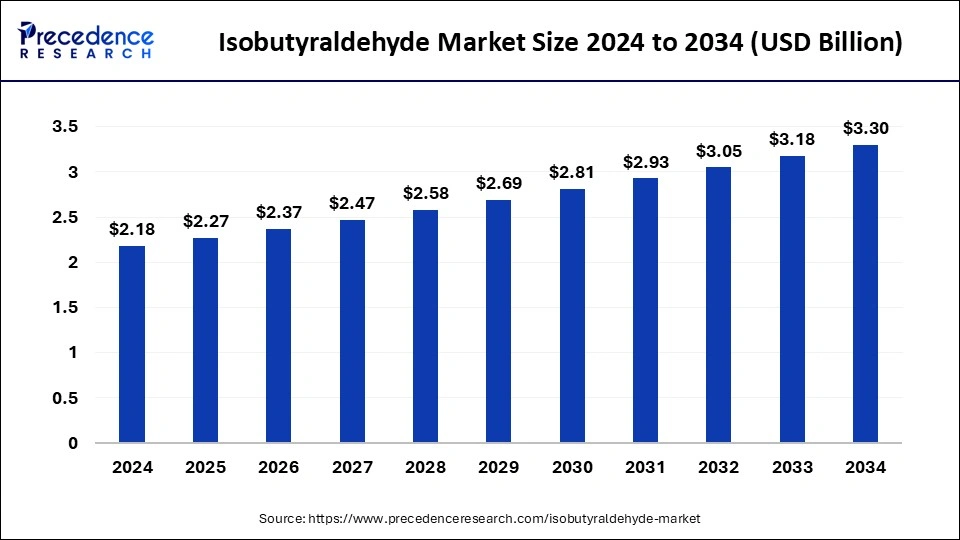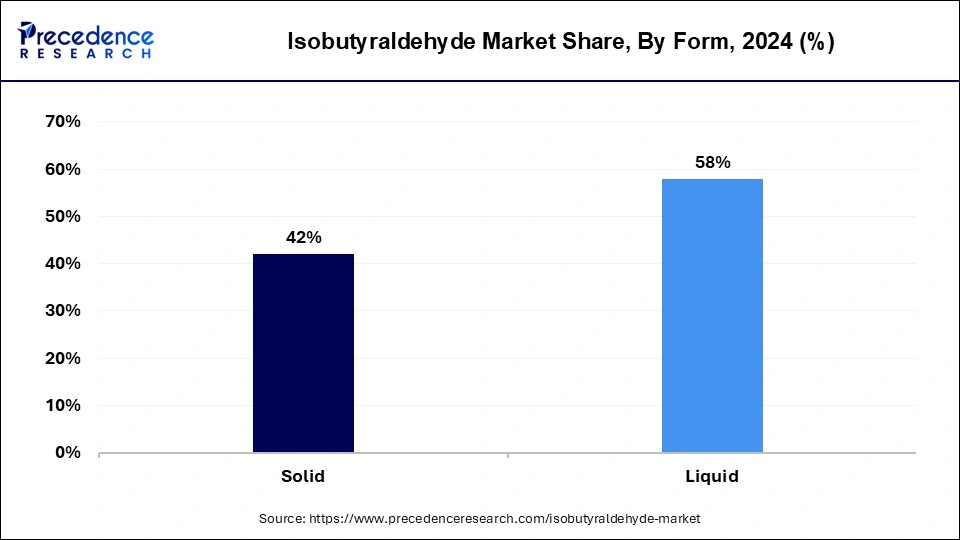The global isobutyraldehyde market size was calculated at USD 2.18 billion in 2024 and is predicted to increase from USD 2.27 billion in 2025 to approximately USD 3.30 billion by 2034, expanding at a CAGR of 3.04% from 2025 to 2034. Isobutyraldehyde is a crucial step in the synthesis of several compounds, including isobutanol, methacrylic acid, and neopentyl glycol.

The chemical formula for isobutyraldehyde, or isobutanal, is (CH3)2CHCHO. It is an organic compound. It is a strong-smelling, colorless liquid. The main application for isobutyraldehyde is an intermediary in synthesizing other compounds, such as flavors, fragrances, and medications. Because isobutyraldehyde is used to make so many downstream compounds, there is a need for it.
One of the main uses is the production of isobutanol, which is then utilized in coatings, solvents, and additives for gasoline. It's also utilized in the synthesis of scents and aromas, such fake whiskey and rum flavors. The demand for the isobutyraldehyde market is rising due to rapid industrialization and expanding chemical manufacturing operations in nations like China and India.
Usually, isobutane is oxidized or isobutyric acid is catalytically hydrogenated in order to produce isobutyraldehyde. In order to maximize costs and logistics, manufacturers are positioned in close proximity to important consuming markets and feedstock suppliers. The isobutyraldehyde market is anticipated to increase moderately due to the increasing use of this product in end-use sectors like flavors, chemicals, and medicines.
In the upcoming years, the transition to bio-based substitutes and sustainable practices may also have an impact on the dynamics of the isobutyraldehyde market. Prices for raw materials, especially isobutane and propylene, can have an impact on isobutyraldehyde prices. Manufacturers face difficulties in adhering to strict environmental rules on emissions and waste management.
| Report Coverage | Details |
| Market Size by 2034 | USD 3.30 Billion |
| Market Size in 2025 | USD 2.27 Billion |
| Market Size in 2024 | USD 2.18 Billion |
| Market Growth Rate from 2025 to 2034 | CAGR of 3.04% |
| Largest Market | Asia Pacific |
| Base Year | 2024 |
| Forecast Period | 2025 to 2034 |
| Segments Covered | Form, Synthesis Method, End-use, and Regions |
| Regions Covered | North America, Europe, Asia-Pacific, Latin America, and Middle East & Africa |
Research and development
The isobutyraldehyde market has seen a concentration of research and development efforts aimed at optimizing production procedures, enhancing product quality, and investigating novel applications. Enhancing isobutyraldehyde manufacturing efficiency is a significant topic of research and development. This involves making the most of chemical reactions like the oxo-process, which is a popular technique for converting olefins into aldehydes. For isobutyraldehyde to be used in a variety of ways, including the creation of tastes, perfumes, and medicinal intermediates, it must be of the highest purity and quality. The main goals of R&D are to improve purifying processes and create analytical tools for quality assurance.
Fluctuating raw material prices
The isobutyraldehyde market can be greatly impacted by fluctuations in the price of raw materials. Propylene and isobutane are common feedstocks for isobutyraldehyde, which is mostly dependent on their price. The cost of making isobutyraldehyde rises in response to rising raw material prices, which may result in higher product pricing for consumers or narrower profit margins for producers. Price volatility may result from isobutane or propylene supply and demand fluctuations.
Cost and availability can be impacted by a variety of factors, including shifts in regulations, geopolitical events, and production interruptions. Prices for raw materials can be impacted by shifts in the demand for isobutyraldehyde or its derivatives on a worldwide scale. Feedstock costs may rise in response to increased demand when suppliers raise prices to keep up with demand.
Biotechnology and renewable chemicals
The isobutyraldehyde market is significantly influenced by biotechnology and renewable chemicals, especially in terms of its development potential and sustainability. Traditionally, petrochemical sources have been utilized to manufacture isobutyraldehyde, a crucial chemical intermediary used in a variety of sectors such as polymers, medicines, and flavors & fragrances.
In order to lessen reliance on fossil fuels, biotechnological procedures frequently employ renewable feedstocks like biomass or agricultural leftovers. This helps achieve sustainability goals and reduces carbon impact. The total economics of manufacturing can be improved by designing biotechnological technologies to be more effective and possibly less energy-intensive than traditional chemical processes. By reducing reliance on erratic petrochemical markets, biotechnology can diversify isobutyraldehyde sources and improve supply chain resilience.
The liquid segment dominated the global isobutyraldehyde market in 2024. The type of isobutyraldehyde that is in a liquid state under typical circumstances (room temperature and atmospheric pressure) is referred to as the liquid sector in the isobutyraldehyde market. The chemical molecule known as isobutyraldehyde itself has the formula (CH₃)â‚‚CHCHO and is made up of a butyraldehyde group and an isopropyl substituent. When isobutyraldehyde is liquid, it usually has a strong smell and is clear and colorless. It can evaporate easily but stays liquid at room temperature due to its boiling point of approximately 74–75°C. The market's liquid sector describes the product's physical condition and particular uses, such as as a crucial chemical intermediate or component in a range of industrial processes and goods.

The solid segment is expected to expand rapidly in the isobutyraldehyde market in the upcoming years. Isobutyraldehyde is used by the pharmaceutical industry to synthesize active pharmaceutical ingredients (APIs). The market for isobutyraldehyde is rising as a result of the growing demand for pharmaceuticals and the growing global healthcare industry. Pesticides and herbicides are among the agricultural compounds that use isobutyraldehyde. The need for increased agricultural production and the growing worldwide population is pushing up demand for agricultural chemicals, which in turn is propelling the market. The market is growing due in part to ongoing research and development efforts to improve the production process and find new uses for isobutyraldehyde. Additionally, advances in sustainable practices and green chemistry are favorably impacting market dynamics.
The oxidation segment held a significant share of the isobutyraldehyde market in 2024. Isobutane is transformed into isobutyraldehyde (C4H8O) by this method, which is then processed further to produce the necessary end products. Technological developments in oxidation processes, regulatory considerations, and demand from downstream industries all have an impact on the isobutyraldehyde industry. Two sectors that rely on isobutyraldehyde are the pharmaceutical fragrance and flavor industries, where it is employed in the manufacture of medicinal intermediates and as a precursor for numerous scent compounds.
The hydroformylation of propene is expected to be the fastest-growing isobutyraldehyde market. Typically, the oxidation process is the carefully regulated interaction of isobutane (C4H10) with air or oxygen (O2), which is frequently aided by metal-based catalysts like palladium or platinum. Isobutane is transformed into isobutyraldehyde (C4H8O) by this method, which is then processed further to produce the necessary end products. Technological developments in oxidation processes, regulatory considerations, and demand from downstream industries all have an impact on the isobutyraldehyde industry. Two sectors that rely on isobutyraldehyde are the pharmaceutical fragrance and flavor industries, where it is employed in the manufacture of medicinal intermediates and as a precursor for numerous scent compounds.
The production segment is expected to grow at the fastest rate in the isobutyraldehyde market during the forecast period. In the chemical industry, isobutanol manufacturing from isobutyraldehyde is important, especially when it comes to fuel additives, solvents, and chemical intermediates. An essential chemical molecule, isobutyraldehyde is used as a precursor to produce a number of other compounds, including isobutanol. The process of converting isobutyraldehyde into isobutanol highlights the significance of each molecule in numerous economic sectors and demonstrates how chemical processes in industrial applications are interconnected. A hydrogenation reaction can be used to further process isobutyraldehyde and get isobutanol (C4H10O). This usually entails the use of hydrogen gas to reduce isobutyraldehyde while a suitable catalyst, like nickel or palladium, is present.
The pharmaceutical intermediates segment is expected to grow rapidly in the isobutyraldehyde market in the upcoming years. Isobutyraldehyde and other pharmaceutical intermediates are essential to many chemical processes in the pharmaceutical sector. An API is created using isobutyraldehyde as a building element for several medications. To create the more complex molecules needed in pharmaceutical formulations, it goes through additional chemical processes.
In the manufacturing procedures of pharmaceuticals, it is employed as a reagent or as a solvent. Because of its chemical makeup, it can be used in certain reactions that are necessary to create medications. An intermediate in organic synthesis, isobutyraldehyde aids in the creation of intermediates and finished medicinal drugs. Its adaptable chemical structure and reactivity make it useful in the research and development stage of drug development for the synthesis and testing of novel medicinal molecules.
Asia Pacific led the isobutyraldehyde market in 2024. Numerous producers of isobutyraldehyde can be found in Asian countries, which helps with the local supply chain. Production capacity held by Asian countries have a big impact on market dynamics. Isobutyraldehyde production processes and market entry of major key players are impacted by environmental regulations and safety standards. For market participants, adherence to laws for evaluation, authorization, and restriction of chemicals is essential. Global economic conditions, technological developments in production techniques, and moves towards sustainable practices all have an impact on the market. These substances have uses in the building, automotive, and pharmaceutical industries, which affects the market for isobutyraldehyde.
North America is observed to grow at a notable rate isobutyraldehyde market during the forecast period. The main applications for isobutyraldehyde are as chemical intermediates in the chemical, pharmaceutical, and agricultural industries. North America's market size, which is driven by technical breakthroughs and industrial expansions, reflects the demand in these industries. Market dynamics are influenced by laws pertaining to isobutyraldehyde manufacturing, storage, and consumption. Adherence to safety and environmental regulations is of utmost importance for market players, as it affects both market entrance barriers and industrial processes. The availability of raw materials (such as isobutane), price volatility, and geopolitical changes are a few examples of factors that might affect the dynamics of the North American market. The use of isobutyraldehyde and its derivatives is also impacted by changes in customer tastes toward environmentally friendly and biobased products.
By Form
By Synthesis Method
By End-use
By Geography
For inquiries regarding discounts, bulk purchases, or customization requests, please contact us at sales@precedenceresearch.com
No cookie-cutter, only authentic analysis – take the 1st step to become a Precedence Research client